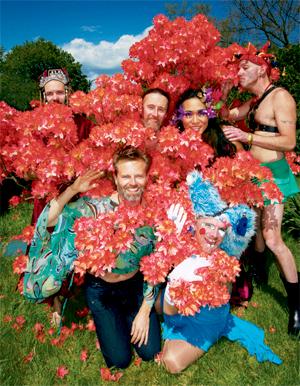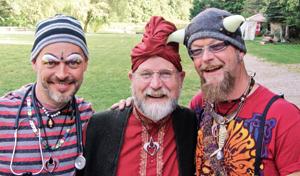
Jade Heart (Gregory Whiting), Marzipan (Nelson Agustin), Celeste EL Phyre (Colin Curtis), Doncha F Lovit (John Swaner) Credit: Richard J Dalton Jr

The author, Sunroom (Richard J Dalton Jr, right), liberates his inner Faerie, with Luke Warmwater (Ken Tomilson). Credit: Richard J Dalton Jr

Clockwise from back left: Holly, Edward, SnapDragon, Marmot, Stitch and Mercy. Credit: Randall cosco
I went to BC Radical Faerie Camp as a reporter seeking to capture Faerie culture, but Faerie culture captured me.
The low-profile Faeries have undergone a resurgence in Vancouver in the last three years, reviving once-dormant weekly coffee events downtown and adding another in East Vancouver. The group held its first BC Faerie Camp last year; I attended the second camp with 72 Faeries on Victoria Day weekend. I was transfixed and transformed, forging genuine bonds with other queer men, a wonderful respite from attitude-filled, frigid Vancouver.
There are no rules, but Faerie rituals turn tradition on its head. Instead of applause, for example, Faeries hiss. Nobody leads Radical Faeries or defines its mission.
There’s a saying that if you ask two Radical Faeries what it’s like to be a Faerie you’ll get four answers. But one website (radfae.org) gives an overview: “Generally, we tend to be gay men who look for a spiritual dimension to our sexuality; many of us are healers of one kind or another. Our shared values include feminism, respect for the Earth, and individual responsibility rather than hierarchy.”
Influenced by pagan, Wiccan and native principles of valuing everyone, the loosely knit group accepts all queer men: old, young, skinny, chubby, tall, short, hairy, smooth, goth and geek, HIV-positive and -negative. Offering hard-to-find acceptance during the AIDS crisis, the Faeries flourished.
At camp, the thawing begins immediately. Strangers are more likely to give a big hug than a firm handshake. There should be a welcoming sign: “Dorothy, we’re not in Vancouver anymore.”
Throughout the weekend, 20-something Royce Edwardsen stands in front of the mirror, going through changes of gender-fuck drag (drag with body hair and genital bulges). Shawl? No shawl? Shawl? No shawl? Finally, his friend Scott Koza says, “Good lord, save some of that mirror for the rest of the weekend.”
Faeries wear drag to amuse others, bend gender stereotypes and celebrate their feminine side. At meals, Faeries in especially vibrant outfits walk down the aisle as everyone bangs utensils against glasses. At some point, each person is the centre of attention, whether walking down the aisle or exposing their vulnerable selves.
At Faerie 101, Robin Hood (Robert Birch) tells the group that in 1979, Harry Hay, a leader in the early gay movement and Faerie co-founder, wanted to create a world where gay men would be safe.
“His great question was ‘What else can “gay” be?’” Robin Hood says, reminding us not to leave anyone out.
“We’ve all been ‘othered,’” he says. “This is a chance to thaw out, where we’re all safe to be free and have fun.”
The opening ceremony is hosted by Grey Shard (Gordon Havelaar), 22, whose piercing blue eyes and warm personality could melt glaciers, and Sequoia (Sequoia Thom), 67, a tantric masseur and life coach who could bring balance even to Britney Spears. In 1979, he attended the first Faerie gathering.
“The men who are attracted to the gathering are just such openhearted men,” Sequoia tells me later. “It was really different from what I was experiencing in The Castro.”
“The Faeries kind of healed the split between my cock and my heart,” he says.
The co-hosts read the Shaman Psalm, including lines such as “Parade your peculiar,” and “This is the hour for amorous revolt.”
Faeries then form two concentric circles, each facing another. I face Home (Jeremy Plotkin). Following instructions, we hold hands and stare into each other’s eyes. Then we do a hand dance, matching the movements of each other’s hands. Next, we move on to another Faerie with another exercise, five times in all. It’s all about connecting.
The closing song, “Everything Possible,” includes the line “You can be anybody you want to be. You can love whomever you will.”
The icebreakers work wonders, says Frank Franze Jr.
“You’re seeing these people with these great smiles on their faces and hugging and really connecting,” he says. “It starts there, and it doesn’t end until Monday. It’s that wonderful.”
The weekend is a testament to the notion that queer men are yearning to escape the aloofness of the West End. All it takes is a place where the norm is closeness and warmth, not distance and frigidity.
Going to Faerie camp and resisting the camaraderie would be like falling in a raging river and fighting the current.
A day into the weekend, I’ve already done naked oil wrestling. I am seduced by Faerie culture — and everyone knows it. I’m not in a Faerie closet; I’m in a sunroom, visible to all. Perhaps, I think, I’ll even travel in August to a Faerie camp in Oregon, one of many Faerie camps around the world.
I don’t have to undergo initiation or pay dues. I need only to participate. I don’t even have to pick a Faerie name. Some have gone by real names for 20 years. Others have changed their Faerie names. Marmot (Neil Fernyhough) saw a vision of a marmot in a sweat lodge and changed his name to Marmot from Snowpants, which he had adopted merely because he saw a pair of snow pants.
The theme of camp is spirit meets flesh, and spirit is an essential part. You can get off on an emotional connection with another person.
Of course, there’s also sex. On Sunday, I escape to write in the often-empty log cabin, and a couple goes into a room upstairs. The ecstasy emanating from behind those doors is far more stimulating than the baroque music that usually accompanies my writing. I’m done writing for the night, and I want a cigarette. (And I don’t smoke.)
In the main lodge, there’s also a cuddle room with mattresses and sheets. Faeries promote sexual liberation, but it’s sex “in the intimate relationship of our shared tribal identity,” according to “Faerie 101: A Purely Personal View,” by Marmot.
Sex is far from central to the weekend. Some people “share” themselves a lot. Others are more reserved. Either is cool. It’s all about respecting each other’s boundaries, and that extends to alcohol and drugs, which are strongly discouraged to respect those in recovery. I saw no one smoke pot or drink alcohol. Several alcoholics announced milestones of abstinence.
The key event, the confidential Heart Circle, is held each morning at camp and monthly in Vancouver. Faeries cuddle and hold hands as they listen to Faeries, one at a time, tell stories of the ups and downs of life, love lost and found, setbacks, childhood trauma, triumphs and celebrations. Everyone bears witness, perhaps shedding a tear, certainly laughing and always gaining insight.
If camp were a conference, Heart Circle would be the morning session partygoers skip. At camp, nearly everyone attends the circle. I tell one Faerie that Heart Circle reminds me of weekend retreats I took as a teenager. He says, “We’re not all that radical.” He’s right.
For the Saturday ritual we head to the lake, listening to a Faerie sing a beautiful song in the darkness in the centre of the lake, slowly approaching shore on a canoe. Then we each throw a stick in a blazing fire, ridding ourselves of something negative.
The weekend is filled with fun: classes on makeup, erotic massage and bondage. Naked, blindfolded Faeries immerse themselves in dance in one event. In line with the disorganized organization, anyone can create a session by writing it on a sheet. On Sunday, hysterically funny Opus (David C Jones) hosts an entertaining talent show that includes drag lip-synching, a striptease accordion-player and impromptu interpretive dance. The camp also offers canoeing, hiking and archery.
Faerie camp has introduced me to a wonderful group of queers who see the true me beyond the reporter’s notebook. There is no closet for me. I am Sunroom.

 Why you can trust Xtra
Why you can trust Xtra


